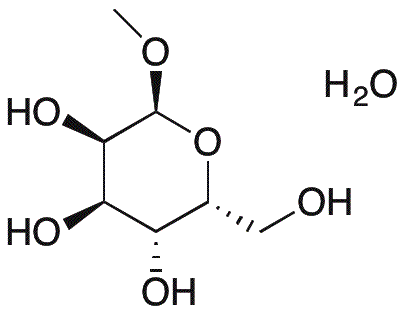Methyl a-D-galactopyranoside monohydrate is widely utilized in research focused on:
- Biochemical Research: This compound serves as a substrate in enzyme assays, particularly for studying glycosyltransferases and other carbohydrate-active enzymes, aiding in the understanding of glycosylation processes.
- Cell Culture: It is used in cell culture media to promote cell growth and differentiation, particularly in studies involving mammalian cells, enhancing the viability and productivity of cell lines.
- Drug Development: The compound is explored in pharmaceutical research for its potential role in drug formulation, particularly in targeting specific receptors or pathways in disease models.
- Food Industry: Methyl a-D-galactopyranoside monohydrate is investigated for its applications as a food additive, where it can enhance sweetness and improve texture in various food products.
- Cosmetic Formulations: It is also used in cosmetic products for its moisturizing properties, helping to improve skin hydration and texture, making it a valuable ingredient in skincare formulations.
General Information
Properties
Safety and Regulations
Applications
Methyl a-D-galactopyranoside monohydrate is widely utilized in research focused on:
- Biochemical Research: This compound serves as a substrate in enzyme assays, particularly for studying glycosyltransferases and other carbohydrate-active enzymes, aiding in the understanding of glycosylation processes.
- Cell Culture: It is used in cell culture media to promote cell growth and differentiation, particularly in studies involving mammalian cells, enhancing the viability and productivity of cell lines.
- Drug Development: The compound is explored in pharmaceutical research for its potential role in drug formulation, particularly in targeting specific receptors or pathways in disease models.
- Food Industry: Methyl a-D-galactopyranoside monohydrate is investigated for its applications as a food additive, where it can enhance sweetness and improve texture in various food products.
- Cosmetic Formulations: It is also used in cosmetic products for its moisturizing properties, helping to improve skin hydration and texture, making it a valuable ingredient in skincare formulations.
Documents
Safety Data Sheets (SDS)
The SDS provides comprehensive safety information on handling, storage, and disposal of the product.
Product Specification (PS)
The PS provides a comprehensive breakdown of the product’s properties, including chemical composition, physical state, purity, and storage requirements. It also details acceptable quality ranges and the product's intended applications.
Certificates of Analysis (COA)
Search for Certificates of Analysis (COA) by entering the products Lot Number. Lot and Batch Numbers can be found on a product’s label following the words ‘Lot’ or ‘Batch’.
Numéro de catalogue
Numéro de lot/série
Certificates Of Origin (COO)
This COO confirms the country where the product was manufactured, and also details the materials and components used in it and whether it is derived from natural, synthetic, or other specific sources. This certificate may be required for customs, trade, and regulatory compliance.
Numéro de catalogue
Numéro de lot/série
Safety Data Sheets (SDS)
The SDS provides comprehensive safety information on handling, storage, and disposal of the product.
DownloadProduct Specification (PS)
The PS provides a comprehensive breakdown of the product’s properties, including chemical composition, physical state, purity, and storage requirements. It also details acceptable quality ranges and the product's intended applications.
DownloadCertificates of Analysis (COA)
Search for Certificates of Analysis (COA) by entering the products Lot Number. Lot and Batch Numbers can be found on a product’s label following the words ‘Lot’ or ‘Batch’.
Numéro de catalogue
Numéro de lot/série
Certificates Of Origin (COO)
This COO confirms the country where the product was manufactured, and also details the materials and components used in it and whether it is derived from natural, synthetic, or other specific sources. This certificate may be required for customs, trade, and regulatory compliance.


